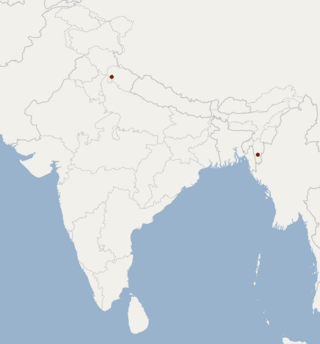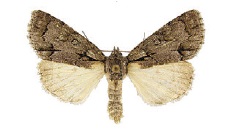
Elasmucha grisea, common name parent bug, is a species of shield bugs or stink bugs belonging to the family Acanthosomatidae. The term parent bugs includes also the other species of the genus Elasmucha and some species of the family Acanthosomatidae.

Magnaporthe grisea, also known as rice blast fungus, rice rotten neck, rice seedling blight, blast of rice, oval leaf spot of graminea, pitting disease, ryegrass blast, Johnson spot, neck blast, wheat blast and Imochi (稲熱), is a plant-pathogenic fungus and model organism that causes a serious disease affecting rice. It is now known that M. grisea consists of a cryptic species complex containing at least two biological species that have clear genetic differences and do not interbreed. Complex members isolated from Digitaria have been more narrowly defined as M. grisea. The remaining members of the complex isolated from rice and a variety of other hosts have been renamed Magnaporthe oryzae, within the same M. grisea complex. Confusion on which of these two names to use for the rice blast pathogen remains, as both are now used by different authors.

An appressorium is a specialized cell typical of many fungal plant pathogens that is used to infect host plants. It is a flattened, hyphal "pressing" organ, from which a minute infection peg grows and enters the host, using turgor pressure capable of punching through even Mylar.
HomoloGene, a tool of the United States National Center for Biotechnology Information (NCBI), is a system for automated detection of homologs among the annotated genes of several completely sequenced eukaryotic genomes.
Prunus grisea is a species of plant in the family Rosaceae. It is found in Malaysia, the Philippines, Singapore, and Taiwan.

Peters's tube-nosed bat is a species of vesper bat in the family Vespertilionidae, found in the Indian Subcontinent, mainly in the Western Himalayas. They have tube-shaped nostrils which assist them with their feeding. They are brown with white-yellow and underparts and have specks of orange around their neck. While they are roosting, their fur, which seems to appear as a dead plant, camouflages them from predators. They are 3.3-6.0 cm in length and have round heads, large eyes and soft fur. This bat is found in India. They are endangered due to clearing of the rain forests in which they live in and are not protected by the World Conservation Union. They feed on rain forest fruit and blossoms.

Stanwellia grisea, also known as the Melbourne trapdoor spider, is a species of mygalomorph spider in the Pycnothelidae family. It is endemic to Australia. It was described in 1901 by British arachnologist Henry Roughton Hogg.

Verdamicin is an aminoglycoside antibiotic produced by Micromonospora grisea.

Acronicta grisea, the gray dagger, is a moth of the family Noctuidae. The species was first described by Francis Walker in 1856. It is found from the Atlantic to the Pacific coast in southern Canada and the northern United States.

Quercus grisea, commonly known as the gray oak, shin oak or scrub oak, is a North American species deciduous or evergreen shrub or medium-sized tree in the white oak group. It is native to the mountains of the southwestern United States and northern Mexico. It hybridises with four other oak species where the ranges overlap, the Arizona white oak (Q. arizonica), the Gambel oak (Q. gambelii), the Mohr oak (Q. mohriana) and the sandpaper oak (Q. pungens).
Papurana grisea is a species of true frog. It is known with certainty only from its type locality in the Went Mountains, in the Indonesian province of Papua, New Guinea. Similar frogs are widespread in New Guinea, usually above 1,200 m (3,900 ft) above sea level, as well as on the Seram Island, but their identity is uncertain; they possibly represent another, undescribed species. Common names Went Mountains frog and Montaen swamp frog have been coined for it.
Etiella grisea is a species of snout moth in the genus Etiella. It was described by George Hampson in 1903. It is found in Sri Lanka, the Chagos Archipelago, Tahiti, the Cook Islands, Samoa, Fiji, the New Hebrides, the Solomon Islands, Australia, the Tanimbar Islands, New Guinea and Guam.

Nicholas José Talbot FRS FRSB is Group Leader and Executive Director at The Sainsbury Laboratory in Norwich.
Sophronica grisea is a species of beetle in the family Cerambycidae. It was described by Per Olof Christopher Aurivillius in 1908.
Anagelasta apicalis is a species of beetle in the family Cerambycidae. It was described by Pic in 1925. It is known from Laos, China and Vietnam.
Anagelasta lineifrons is a species of beetle in the family Cerambycidae. It was described by Gressitt in 1951. It is known from China.
Anagelasta nigromaculata is a species of beetle in the family Cerambycidae. It was described by Stephan von Breuning in 1938. It is known from India.
Anagelasta transversevittata is a species of beetle in the family Cerambycidae. It was described by Stephan von Breuning in 1964. It is known from Laos.
Anagelasta trimaculata is a species of beetle in the family Cerambycidae. It was described by Stephan von Breuning in 1938. It is known from India.

Montipora grisea is a small polyped stony coral in the family Acroporidae.









